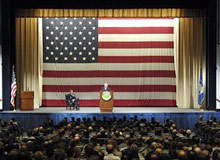
When US Defense Secretary Robert Gates fired USAF Secretary Michael Wynne and Chief of Staff General Michael Moseley – the top two leaders of the US Air Force – in June 2008, it was for reasons that had nothing to do with innovation and everything to do with operations. However, the law of unintended consequences suggests that technological choices could be among the most profound consequences of the shakeup.
Perhaps not surprisingly for a former USAF missile officer and CIA director, Gates had voiced displeasure with the Air Force’s leadership prior to the disclosure of the nuclear weapons gaffes and the subsequent Kirkland report.
The earlier criticism centred on the deployment of UAVs, or more precisely, the lack thereof.
UNDERPERFORMING UAVS
In speeches at the Air War College and at West Point, Gates expressed irritation at what he implied was a less than wholehearted commitment by the USAF to maximising UAV deployment in Iraq and Afghanistan. “I’ve been wrestling for months to get more intelligence, surveillance and reconnaissance assets into the theatre,” said Gates, who added that because major portions of the military leadership have been “stuck in old ways of doing business, it’s been like pulling teeth.”
Although Gates did not single out the USAF brass explicitly, the complaint primarily concerned the higher-flying, more capable Predators, Reapers, and Global Hawks flown by the USAF, in contrast to the much smaller Ravens and similar mini-UAVs that the Army deploys at company level. In early 2007, for example, the USAF could not put more than 11 Predators over the Middle East at any given time.

US Tariffs are shifting - will you react or anticipate?
Don’t let policy changes catch you off guard. Stay proactive with real-time data and expert analysis.
By GlobalDataTellingly, high-altitude UAV coverage has improved in a remarkably short time. By 5 June, the day Gates axed Wynne and Moseley, the maximum number of Predators that the USAF could deploy over the regional battlefields had risen to 25. Evidently, USAF leaders responded to pressure rather than a pink slip, but if they could more than double coverage in six weeks, what factors caused the shortage to begin with?
SHORTAGE IN THE SKIES
The comforting answer would be that some kind of technical glitch or production bottleneck had hindered deployment, and that the USAF solved this problem on its own, coincident with Gates’s speech on 21 April 2008 at Maxwell. To date, though, nobody has identified such a showstopper. Consequently, other unflattering possibilities come to mind, such as management ability and organisational psychology.
In mid-April, according to Gates, he established a Pentagon-wide unit ‘much like the MRAP task force, to work this problem in the weeks to come, to find more innovative and bold ways to help those on the ground’. Perhaps this unit was an all-star team infused with a sense of urgency by their boss, but if so, it doesn’t say much about the USAF’s notional ability to manage all UAV procurement.
Some observers perceive the UAV shortage problem as a new twist on the old problem of the ‘white-scarf’ aviator mafia being less than enthusiastic about providing support if they aren’t going to get the glory of the kill. When culturally ingrained within an organisation, this kind of attitude causes other problems—such as the nuclear malaise outlined in Admiral Kirkland’s report.
The irony here is that since 2005, the USAF has been campaigning for a role as executive agent for all UAVs that operate above 3,500ft. This effort is a story unto itself, but suffice to say that arguing for an expanded mandate becomes more difficult if key decision makers don’t like the handling of the existing mandate.
Beyond such issues lies an even more fundamental question: does the USAF officer corps harbour ambivalence about or even fear of UAVs as robots that will make them superfluous? In his speech, Gates specified that the mismatch between UAV value and availability “may require rethinking long-standing service assumptions and priorities about which missions require certified pilots and which do not.”
Once this kind of basic, blank-slate reassessment begins, there’s often no telling where it will lead. Future pieces will address some of the most likely areas of profound change, but for now, one thing is clear: in a Gates-run Pentagon, refusing to do any reassessment will probably lead to the unemployment office.



